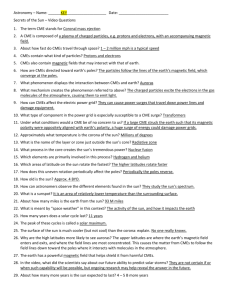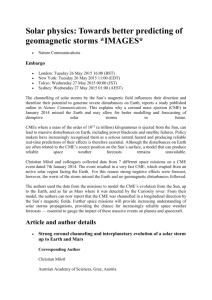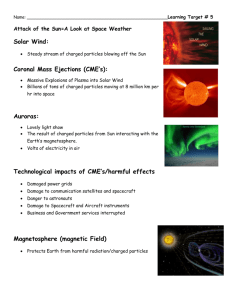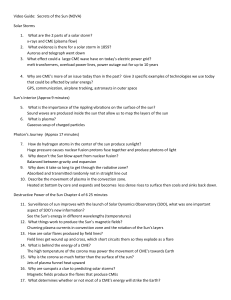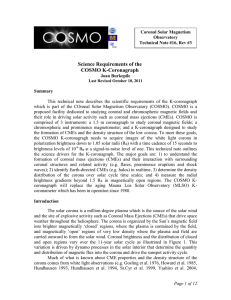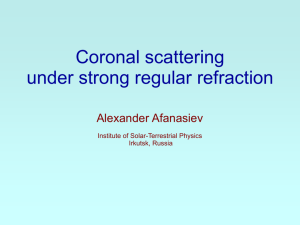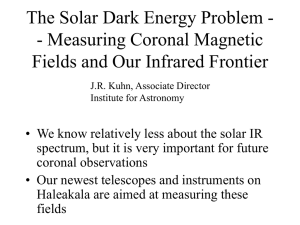Overview of CISM Solar/Heliospheric Research
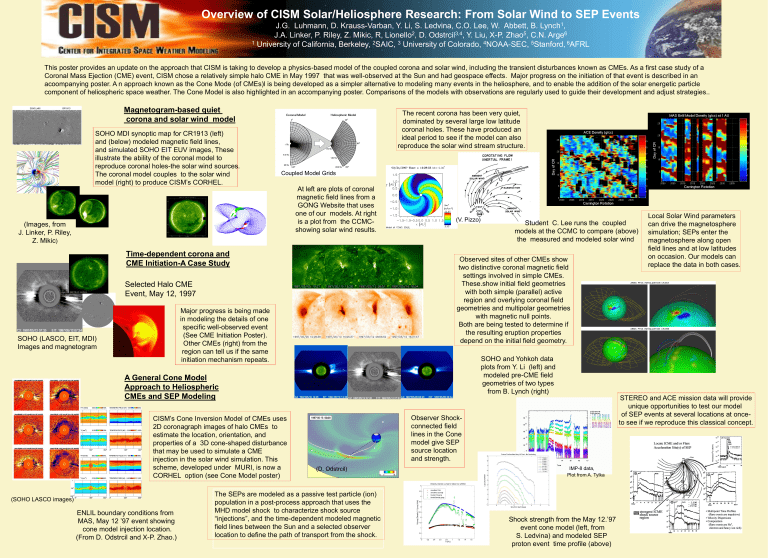
Overview of CISM Solar/Heliosphere Research: From Solar Wind to SEP Events
J.G. Luhmann, D. Krauss-Varban, Y. Li, S. Ledvina, C.O. Lee, W. Abbett, B. Lynch 1 ,
1
J.A. Linker, P. Riley, Z. Mikic, R, Lionello 2 , D. Odstrcil 3,4 , Y. Liu, X-P. Zhao 5 , C.N. Arge 6
University of California, Berkeley, 2 SAIC, 3 University of Colorado, 4 NOAA-SEC, 5 Stanford, 6 AFRL
This poster provides an update on the approach that CISM is taking to develop a physics-based model of the coupled corona and solar wind, including the transient disturbances known as CMEs. As a first case study of a
Coronal Mass Ejection (CME) event, CISM chose a relatively simple halo CME in May 1997 that was well-observed at the Sun and had geospace effects. Major progress on the initiation of that event is described in an acoompanying poster. A n approach known as the Cone Mode (of CMEs)l is being developed as a simpler alternative to modeling many events in the heliosphere, and to enable the addition of the solar energetic particle component of heliospheric space weather. The Cone Model is also highlighted in an accompanying poster. Comparisons of the models with observations are regularly used to guide their development and adjust strategies..
Magnetogram-based quiet corona and solar wind model
SOHO MDI synoptic map for CR1913 (left) and (below) modeled magnetic field lines,
The recent corona has been very quiet, dominated by several large low latitude coronal holes. These have produced an ideal period to see if the model can also reproduce the solar wind stream structure.
reproduce coronal holes-the solar wind sources.
The coronal model couples to the solar wind model (right) to produce CISM’s CORHEL.
(Images, from
J. Linker, P. Riley,
Z. Mikic
)
Coupled Model Grids
At left are plots of coronal magnetic field lines from a
GONG Website that uses one of our models. At right is a plot from the CCMCshowing solar wind results.
SOHO (LASCO, EIT, MDI)
Images and magnetogram
Time-dependent corona and
CME Initiation-A Case Study
Selected Halo CME
Event, May 12, 1997
Major progress is being made in modeling the details of one specific well-observed event
(See CME Initiation Poster).
Other CMEs (right) from the region can tell us if the same initiation mechanism repeats.
A General Cone Model
Approach to Heliospheric
CMEs and SEP Modeling
(SOHO LASCO images)
CISM’s Cone Inversion Model of CMEs uses
2D coronagraph images of halo CMEs to estimate the location, orientation, and properties of a 3D cone-shaped disturbance that may be used to simulate a CME injection in the solar wind simulation. This scheme, developed under MURI, is now a
CORHEL option (see Cone Model poster)
ENLIL boundary conditions from
MAS, May 12 ’97 event showing cone model injection location.
(From D. Odstrcil and X-P. Zhao.)
(D. Odstrcil)
The SEPs are modeled as a passive test particle (ion) population in a post-process approach that uses the
MHD model shock to characterize shock source
“injections”, and the time-dependent modeled magnetic field lines between the Sun and a selected observer location to define the path of transport from the shock.
Observer Shockconnected field lines in the Cone model give SEP source location and strength.
(V. Pizzo)
Student C. Lee runs the coupled models at the CCMC to compare (above) the measured and modeled solar wind
Local Solar Wind parameters can drive the magnetosphere simulation; SEPs enter the magnetosphere along open field lines and at low latitudes on occasion. Our models can replace the data in both cases.
Observed sites of other CMEs show two distinctive coronal magnetic field settings involved in simple CMEs.
These.show initial field geometries with both simple (parallel) active region and overlying coronal field geometries and multipolar geometries with magnetic null points.
Both are being tested to determine if the resulting eruption properties depend on the initial field geometry.
SOHO and Yohkoh data plots from Y. Li (left) and modeled pre-CME field geometries of two types from B. Lynch (right)
STEREO and ACE mission data will provide unique opportunities to test our model of SEP events at several locations at onceto see if we reproduce this classical concept.
IMP-8 data,
Plot from A. Tylka
Shock strength from the May 12.’97 event cone model (left, from
S. Ledvina) and modeled SEP proton event time profile (above)
